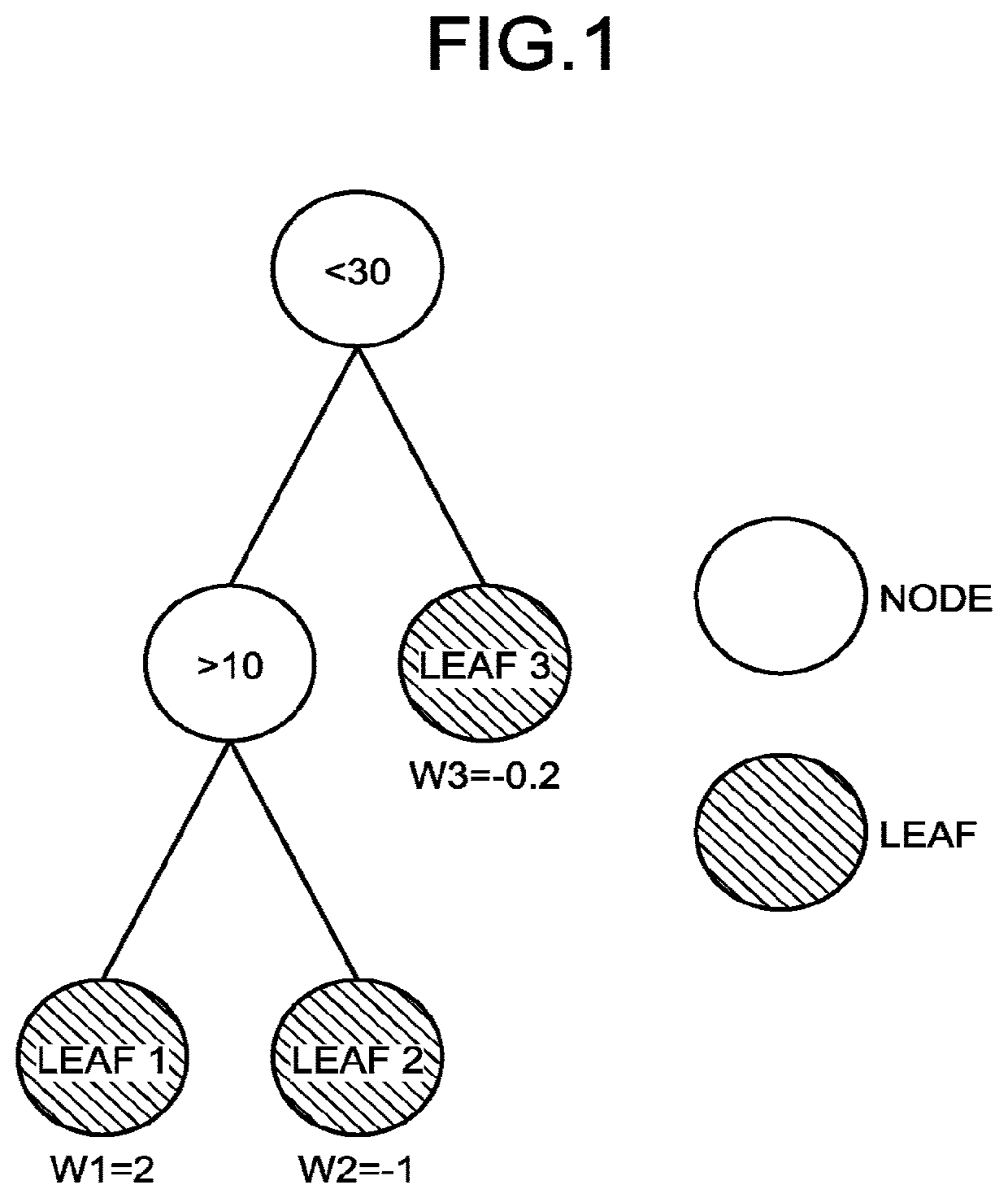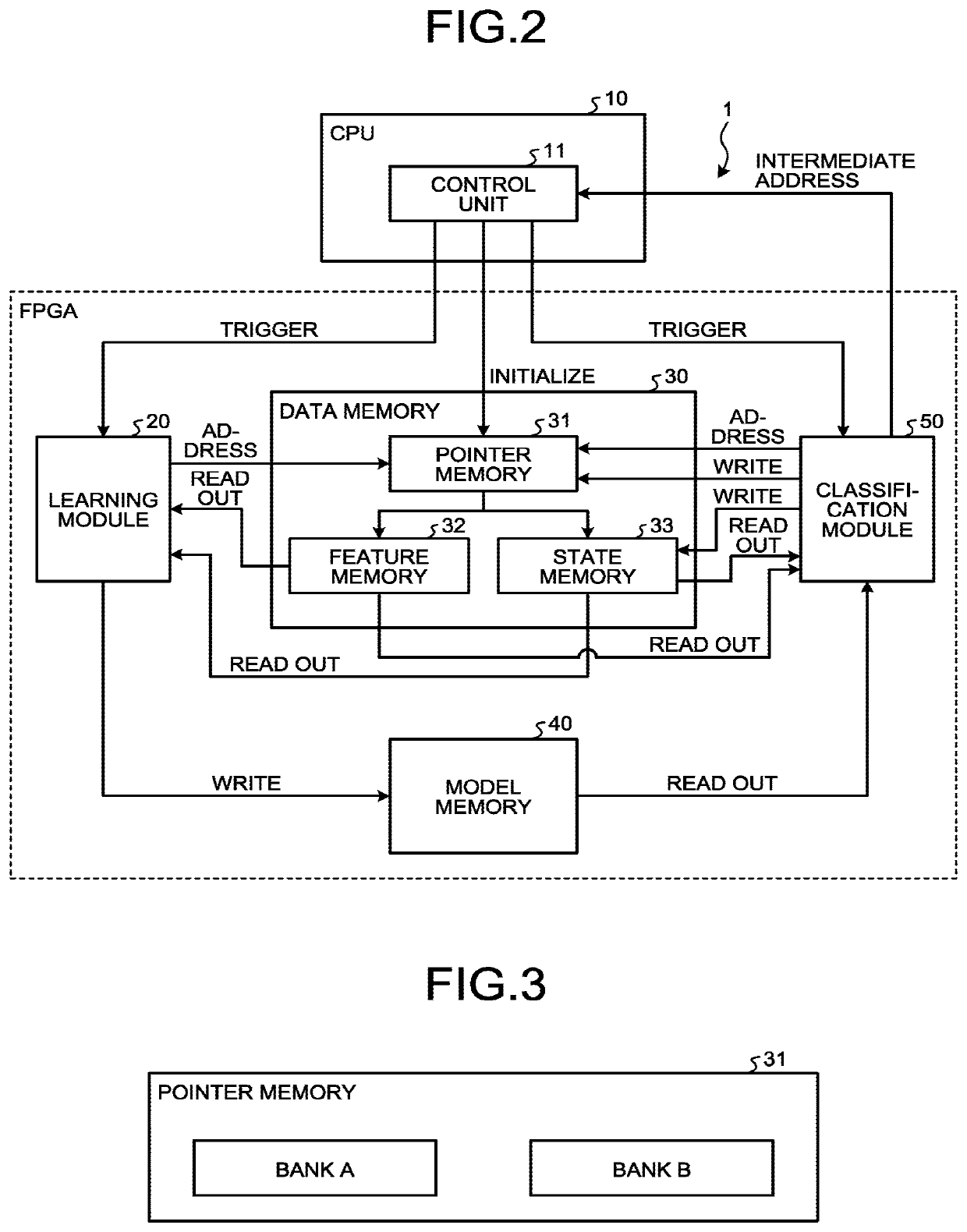Learning and discrimination device, and learning and discrimination method
a learning and discrimination device and learning and discrimination technology, applied in the field of learning and discrimination devices, learning and discrimination methods, can solve the problems of poor input data accuracy, limit of accuracy, and limit of processing speed
- Summary
- Abstract
- Description
- Claims
- Application Information
AI Technical Summary
Benefits of technology
Problems solved by technology
Method used
Image
Examples
first embodiment
[0050]Regarding Logic of GBDT
[0051]In DL as an algorithm of high-performance machine learning, a discriminator is attempted to be implemented by various kinds of hard logic, which has been found to have higher power efficiency as compared with processing using a graphics processing unit (GPU). However, an architecture of the GPU closely matches to especially a CNN in the field of DL, so that, in view of speed, speed of discrimination performed by a field-programmable gate array (FPGA) implemented with logic is not higher than that of the GPU. On the other hand, hard logic has been attempted to be implemented by FPGA on a decision tree-based algorithm such as a GBDT, and a result of higher speed than the GPU has been reported. This is because, as described later, the decision tree-based algorithm is not appropriate for the architecture of the GPU in view of a feature of data arrangement thereof.
[0052]Examination as to learning falls behind examination as to discrimination in the worl...
second embodiment
[0173]The following describes the learning and discrimination device according to a second embodiment, mainly about differences from the learning and discrimination device 1 according to the first embodiment. The first embodiment describes the learning processing and the discrimination processing by the GBDT assuming that there is one data memory 30 in which the sample data is stored. The present embodiment describes an operation of performing learning processing by dividing the data memory into a plurality of parts to implement Data Parallel for processing a plurality of pieces of sample data in parallel.
[0174]Regarding Data Parallel
[0175]FIG. 16 is a diagram illustrating an example of a module configuration of the learning and discrimination device to which Data Parallel is applied. With reference to FIG. 16, the following describes a configuration of a learning and discrimination device 1a as an example of a configuration for implementing Data Parallel.
[0176]To implement Data Par...
third embodiment
[0282]The following describes the learning and discrimination device according to a third embodiment, mainly about differences from the learning and discrimination device according to the second embodiment. In the first embodiment and the second embodiment, the feature amount included in the sample data is assumed to be a numerical value data the numerical value of which is meaningful. The present embodiment describes a configuration and an operation that can process, as a learning target, the feature amount (category feature amount) having meaning as an identifier indicating a specific category instead of the numerical value data.
[0283]Operation of Calculating Sum of Gradient Information Using One Hot Encoding
[0284]First, the following describes an operation of calculating the sums GL, GR, HL, and HR of the gradient information by encoding the category feature amount by One Hot Encoding described above. For example, sample data including the category feature amount as represented b...
PUM
 Login to View More
Login to View More Abstract
Description
Claims
Application Information
 Login to View More
Login to View More - R&D
- Intellectual Property
- Life Sciences
- Materials
- Tech Scout
- Unparalleled Data Quality
- Higher Quality Content
- 60% Fewer Hallucinations
Browse by: Latest US Patents, China's latest patents, Technical Efficacy Thesaurus, Application Domain, Technology Topic, Popular Technical Reports.
© 2025 PatSnap. All rights reserved.Legal|Privacy policy|Modern Slavery Act Transparency Statement|Sitemap|About US| Contact US: help@patsnap.com



